手动实现 Spring 底层机制【初始化 IOC容器+依赖注入+BeanPostProcessor 机制+AOP】【任务1-6整合版】
引言:Spring框架的ioc容器、依赖注入、BeanPostProcessor后置处理器、AOP面向切面编程等特点为我们的开发带来了极大的便利,但是我们不能只学其中的api,更要懂得Spring的底层机制。
思考Spring框架是如何实现以下功能
Spring 注解方式注入 bean
原生 Spring 如何实现依赖注入和 singleton、prototype
Spring 底层实现,如何实现 IOC 容器创建和初始化
Spring 底层实现, 如何实现 getBean, 根据 singleton 和 prototype 来返回 bean 实例
Spring 如何实现 BeanPostProcessor后置处理器机制
Spring AOP 动态代理实现
下面我来手动实现一下Spring的底层机制【初始化 IOC容器+依赖注入+BeanPostProcessor 机制+AOP】
前置知识:java反射+IO+动态代理+Spring
目录
- 手动实现 Spring 底层机制【初始化 IOC容器+依赖注入+BeanPostProcessor 机制+AOP】【任务1-6整合版】
- **==程序框架图==**
- **==一、实现任务阶段 1- 编写自己 Spring 容器,实现扫描包, 得到 bean 的 class 对象==**
- ==二、实现任务阶段 2- 扫描将 bean 信息封装到 BeanDefinition 对象, 并放入到 Map==
- ==三、实现任务阶段 3- 初始化 bean 单例池,并完成 getBean 方法 , createBean 方法==
- ==四、**实现任务阶段** **4-** **完成依赖注入**==
- ==五、**实现任务阶段** **5- bean** **后置处理器实现**==
- ==**六、实现任务阶段 6- AOP 机制实现**==
- ==**七、手动实现 Spring 底层机制【初始化 IOC容器+依赖注入+BeanPostProcessor 机制+AOP】完整代码**==
程序框架图
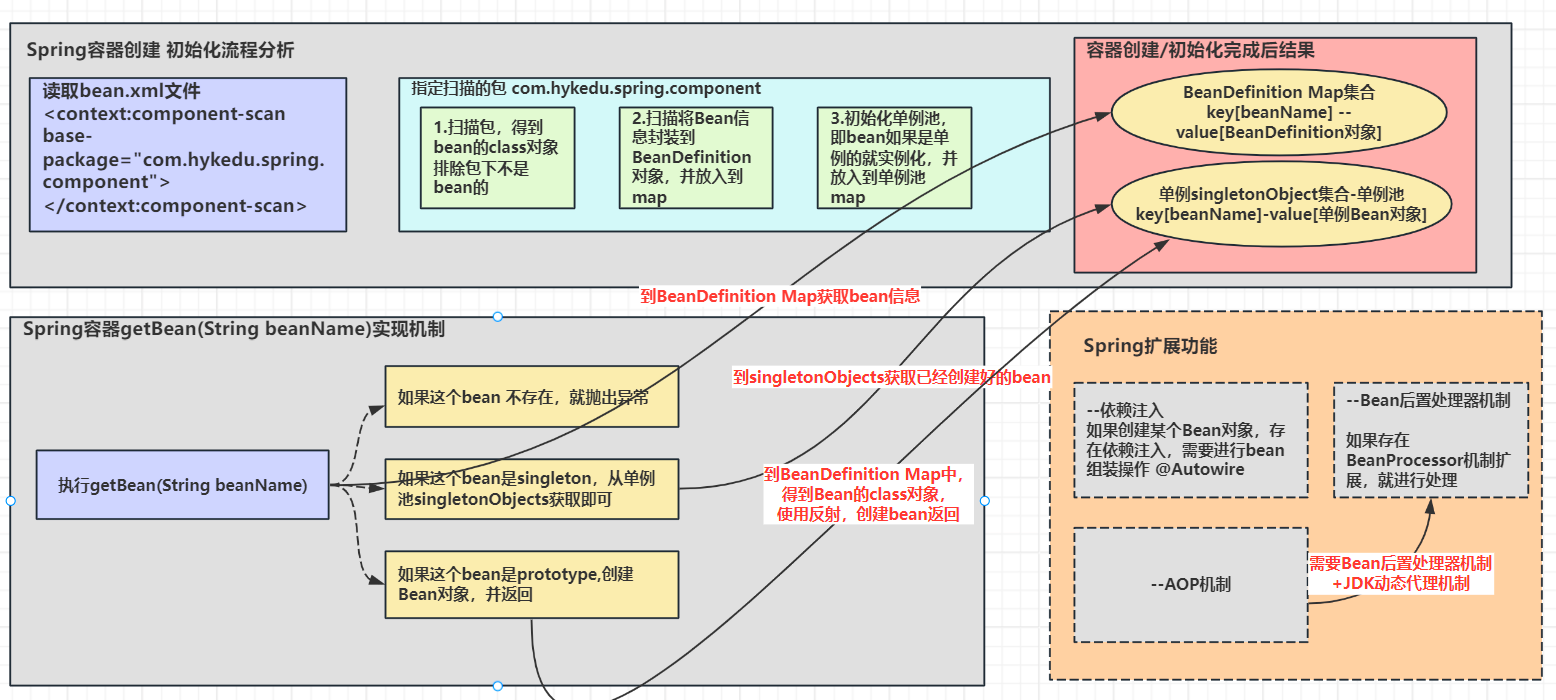
一、实现任务阶段 1- 编写自己 Spring 容器,实现扫描包, 得到 bean 的 class 对象

1.先创建一个名为mySpring的Maven项目
目录结构
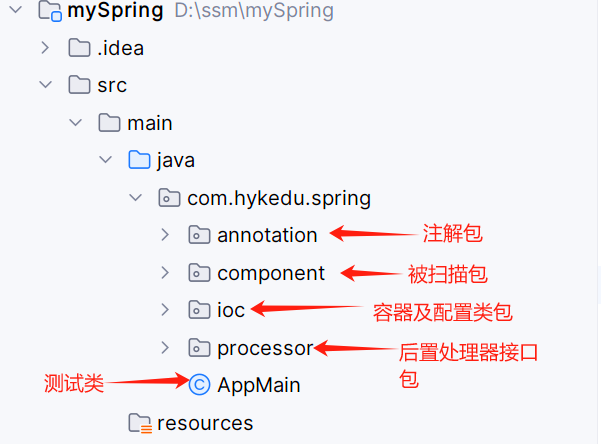
2.在annotation包下定义ComponentScan注解,该注解的value就是要扫描的包
package com.hykedu.spring.annotation;
import java.lang.annotation.ElementType;
import java.lang.annotation.Retention;
import java.lang.annotation.RetentionPolicy;
import java.lang.annotation.Target;
/**
* @author 程序员蛇皮
* @version 1.0
* 1.@Target(ElementType.TYPE)指定我们的 ComponentScan注解可以修饰 Type程序元素
* 2.@Retention(RetentionPolicy.RUNTIME) ComponentScan注解 保留范围
* 3.String value() default ""; 表示 ComponentScan注解 可以传入value
*/
@Target(ElementType.TYPE)
@Retention(RetentionPolicy.RUNTIME)
public @interface ComponentScan {
String value() default "";
}
3.在ioc包下定义CodeSnakeSpringConfig.java,在该类实现ComponentScan注解,该注解的value就是要扫描的包
package com.hykedu.spring.ioc;
import com.hykedu.spring.annotation.ComponentScan;
/**
* @author 程序员蛇皮
* @version 1.0
* 这是一个配置类,作用类似于原生Spring的 beans.xml 容器配置文件
*/
@ComponentScan(value = "com.hykedu.spring.component")
public class CodeSnakeSpringConfig {
}
4.我们知道Spring扫描包下的类的注解有Component、Controller、Repository、Service,这里我们只在annotation包下定义Component注解做一个示范,其他注解作用非常类似,为了简化流程,这里不写代码示范了
package com.hykedu.spring.annotation;
import java.lang.annotation.ElementType;
import java.lang.annotation.Retention;
import java.lang.annotation.RetentionPolicy;
import java.lang.annotation.Target;
/**
* @author 程序员蛇皮
* @version 1.0
* 1.@Target(ElementType.TYPE)指定我们的 ComponentScan注解可以修饰 Type程序元素
* 2.@Retention(RetentionPolicy.RUNTIME) ComponentScan注解 保留范围
* 3.String value() default ""; 表示 ComponentScan注解 可以传入value
*/
@Target(ElementType.TYPE)
@Retention(RetentionPolicy.RUNTIME)
public @interface Component {
String value() default "";
}
5.在ioc包定义CodeSnakeSpringApplicationContext类,CodeSnakeSpringApplicationContext 类的作用类似Spring原生ioc容器
package com.hykedu.spring.ioc;
import com.hykedu.spring.annotation.Component;
import com.hykedu.spring.annotation.ComponentScan;
import java.io.File;
import java.net.URL;
/**
* @author 程序员蛇皮
* @version 1.0
* CodeSnakeSpringApplicationContext 类的作用类似Spring原生ioc容器
*/
@SuppressWarnings("all")
public class CodeSnakeSpringApplicationContext {
private Class configClass;
public CodeSnakeSpringApplicationContext(Class configClass) {
this.configClass = configClass;
System.out.println(configClass);
//获取要扫描的包
//1.先得到SpringConfig配置的@ComponentScan(value = "com.hykedu.spring.component")
ComponentScan componentScan = (ComponentScan) this.configClass.getDeclaredAnnotation(ComponentScan.class);
//2.componentScan的value就是我们要扫描的包
String path = componentScan.value();
System.out.println("要扫描的包:" + path);
//得到要扫描的包下所有的资源(类.class)
//1.得到类的加载器
ClassLoader classLoader = CodeSnakeSpringApplicationContext.class.getClassLoader();
//2.通过类加载器获取到要扫描包的url
path = path.replace(".", "/");//把 . 替换成路径间隔符 /
URL resource = classLoader.getResource(path);
System.out.println("要扫描包的url:" + resource);
//3.将要加载的资源(.class) 路径下的文件进行遍历=>io
File file = new File(resource.getFile());
if (file.isDirectory()) {//pand
File[] files = file.listFiles();
for (File f : files) {
String absolutePath = f.getAbsolutePath();
System.out.println("文件的绝对路径:" + absolutePath);
//这里我们只处理.class文件
if (absolutePath.endsWith(".class")) {
//1.获取到类名
String className = absolutePath.substring
(absolutePath.lastIndexOf("\\") + 1, absolutePath.lastIndexOf(".class"));
System.out.println("类名:" + className);
//2.获取类的完整路径(全类名)
String classFullName = path.replace("/", ".") + "." + className;
System.out.println("全类名:" + classFullName);
//3.判断该类是否需要注入容器,判断该类是不是有@Component/@Controller/@Repository/@Service注解
try {
Class<?> clazz = classLoader.loadClass(classFullName);
if (clazz.isAnnotationPresent(Component.class)) {
//如果在注解指定了value,将其赋值给className
System.out.println("这是一个Spring bean" + clazz);
} else {
System.out.println("这不是一个Spring bean" + clazz);
}
} catch (Exception e) {
throw new RuntimeException(e);
}
}
}
}
}
}
6.测试能否识别带有Component注解的类
在Component包下分别定义没有Component注解的Car类和带有Component注解的StudentDao和StudentService
类,看看程序能否识别出来哪个是Bean对象,哪个不是Bean对象
package com.hykedu.spring.component;
/**
* @author 程序员蛇皮
* @version 1.0
*/
public class Car {
}
package com.hykedu.spring.component;
import com.hykedu.spring.annotation.Component;
/**
* @author 程序员蛇皮
* @version 1.0
*/
@Component
public class StudentDao {
}
package com.hykedu.spring.component;
import com.hykedu.spring.annotation.Component;
/**
* @author 程序员蛇皮
* @version 1.0
*/
@Component
public class StudentService {
}
测试方法AppMain
package com.hykedu.spring;
import com.hykedu.spring.ioc.CodeSnakeSpringApplicationContext;
import com.hykedu.spring.ioc.CodeSnakeSpringConfig;
/**
* @author 程序员蛇皮
* @version 1.0
*/
public class AppMain {
public static void main(String[] args) {
CodeSnakeSpringApplicationContext codeSnakeSpringApplicationContext = new CodeSnakeSpringApplicationContext(CodeSnakeSpringConfig.class);
System.out.println("ok");
}
}
测试结果(成功扫描到了Bean对象)
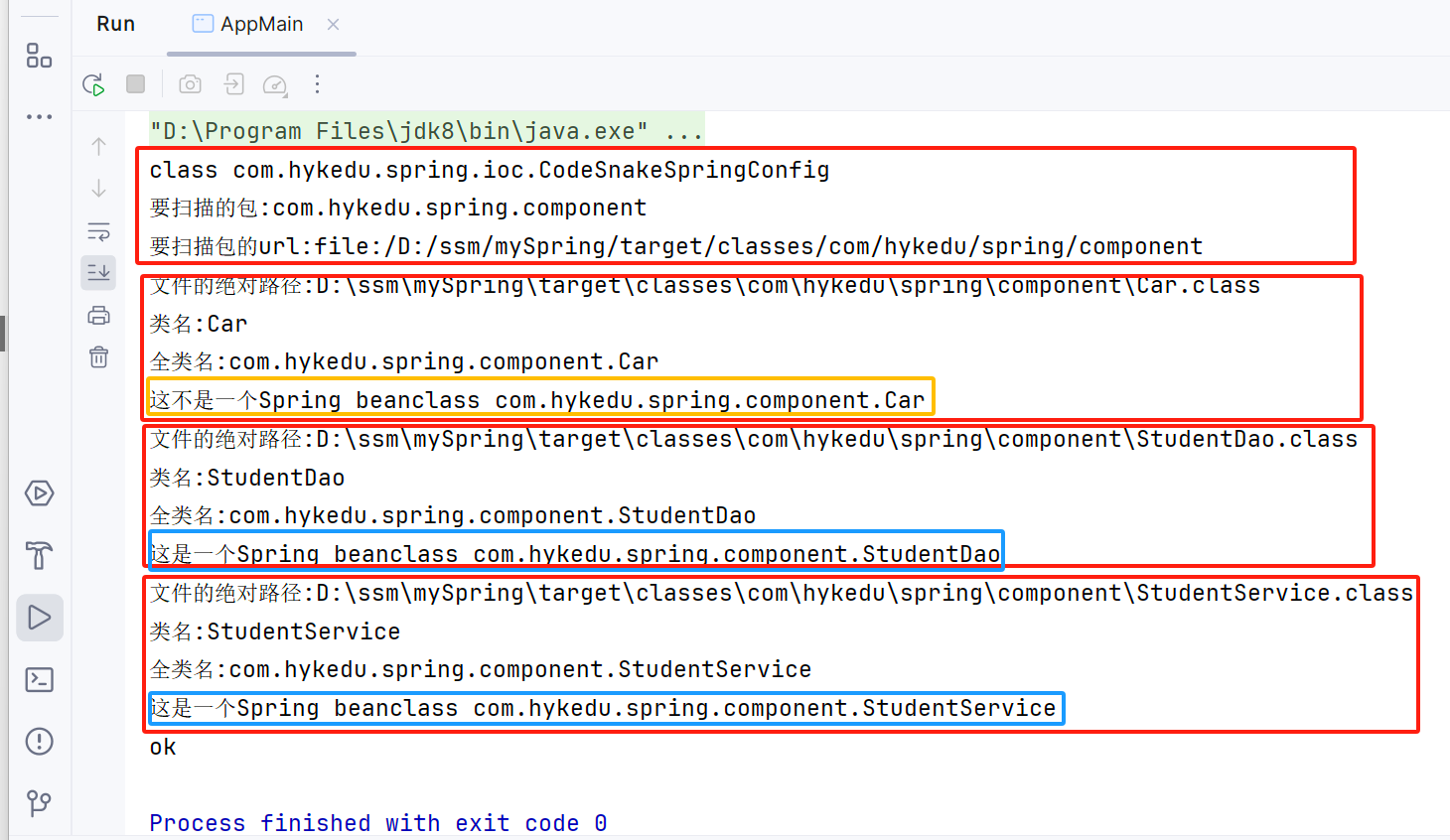
二、实现任务阶段 2- 扫描将 bean 信息封装到 BeanDefinition 对象, 并放入到 Map

1.在ioc包定义BeanDefinition类,用于封装/记录Bean的信息[1.scope 2.Bean对应的Class对象,反射可以生成对应的对象
package com.hykedu.spring.ioc;
/**
* @author 程序员蛇皮
* @version 1.0
* BeanDefinition 用于封装/记录Bean的信息[1.scope 2.Bean对应的Class对象,反射可以生成对应的对象
*/
@SuppressWarnings("all")
public class BeanDefinition {
private String scope;
private Class clazz;
public String getScope() {
return scope;
}
public void setScope(String scope) {
this.scope = scope;
}
public Class getClazz() {
return clazz;
}
public void setClazz(Class clazz) {
this.clazz = clazz;
}
@Override
public String toString() {
return "BeanDefinition{" +
"scope='" + scope + '\'' +
", clazz=" + clazz +
'}';
}
}
2.在annotation包定义Scope注解,可以指定bean的作用范围[singleton(单例),prototype(多例)]
package com.hykedu.spring.annotation;
import java.lang.annotation.ElementType;
import java.lang.annotation.Retention;
import java.lang.annotation.RetentionPolicy;
import java.lang.annotation.Target;
/**
* @author 程序员蛇皮
* @version 1.0
* Scope可以指定bean的作用范围[singleton,prototype]
*/
@Target(ElementType.TYPE)
@Retention(RetentionPolicy.RUNTIME)
public @interface Scope {
String value() default "";
}
3.在pom.xml引入commons-lang包(需要用到里面的StringUtils工具类)
<dependencies>
<dependency>
<groupId>commons-lang</groupId>
<artifactId>commons-lang</artifactId>
<version>2.6</version>
</dependency>
</dependencies>
4.在CodeSnakeSpringApplicationContext类中定义存放BeanDefinition的容器,并将Bean对象放入其中,同时将其封装成scanBeanDefinition(Class configClass)方法,在构造器中调用
package com.hykedu.spring.ioc;
import com.hykedu.spring.annotation.Component;
import com.hykedu.spring.annotation.ComponentScan;
import com.hykedu.spring.annotation.Scope;
import org.apache.commons.lang.StringUtils;
import java.io.File;
import java.net.URL;
import java.util.concurrent.ConcurrentHashMap;
/**
* @author 程序员蛇皮
* @version 1.0
* SpringApplicationContext 类的作用类似Spring原生ioc容器
*/
@SuppressWarnings("all")
public class CodeSnakeSpringApplicationContext {
private Class configClass;
//定义beanDefinitionMap,存放BeanDefinition对象
private final ConcurrentHashMap<String, BeanDefinition> beanDefinitionMap = new ConcurrentHashMap<>();
public CodeSnakeSpringApplicationContext(Class configClass) {
scanBeanDefinition(configClass);
}
//该方法完成的对指定包的扫描,并将Bean信息封装到BeanDefinition对象,再放入map
private void scanBeanDefinition(Class configClass) {
this.configClass = configClass;
System.out.println(configClass);
//获取要扫描的包
//1.先得到SpringConfig配置的@ComponentScan(value = "com.hykedu.spring.component")
ComponentScan componentScan = (ComponentScan) this.configClass.getDeclaredAnnotation(ComponentScan.class);
//2.componentScan的value就是我们要扫描的包
String path = componentScan.value();
System.out.println("要扫描的包:" + path);
//得到要扫描的包下所有的资源(类.class)
//1.得到类的加载器
ClassLoader classLoader = CodeSnakeSpringApplicationContext.class.getClassLoader();
//2.通过类加载器获取到要扫描包的url
path = path.replace(".", "/");//把 . 替换成路径间隔符 /
URL resource = classLoader.getResource(path);
System.out.println("要扫描包的url:" + resource);
//3.将要加载的资源(.class) 路径下的文件进行遍历=>io
File file = new File(resource.getFile());
if (file.isDirectory()) {//pand
File[] files = file.listFiles();
for (File f : files) {
String absolutePath = f.getAbsolutePath();
System.out.println("文件的绝对路径:" + absolutePath);
//这里我们只处理.class文件
if (absolutePath.endsWith(".class")) {
//1.获取到类名
String className = absolutePath.substring
(absolutePath.lastIndexOf("\\") + 1, absolutePath.lastIndexOf(".class"));
System.out.println("类名:" + className);
//2.获取类的完整路径(全类名)
String classFullName = path.replace("/", ".") + "." + className;
System.out.println("全类名:" + classFullName);
//3.判断该类是否需要注入容器,判断该类是不是有@Component/@Controller/@Repository/@Service注解
try {
Class<?> clazz = classLoader.loadClass(classFullName);
if (clazz.isAnnotationPresent(Component.class)) {
//如果在注解指定了value,将其赋值给className
System.out.println("这是一个Spring bean" + clazz);
Component componentAnnotation = clazz.getDeclaredAnnotation(Component.class);
String beanName = componentAnnotation.value();
if (beanName.equals("")) {
//将类名首字母小写作为beanName
beanName = StringUtils.uncapitalize(className);
}
BeanDefinition beanDefinition = new BeanDefinition();
beanDefinition.setClazz(clazz);
if (clazz.isAnnotationPresent(Scope.class)) {
//如果配置了Scope,获取他配置的值
Scope scopeAnnotation = clazz.getDeclaredAnnotation(Scope.class);
beanDefinition.setScope(scopeAnnotation.value());
} else {
//如果没有配置值,就默认Singleton
beanDefinition.setScope("singleton");
}
//将beanDefinition放入beanDefinitionMap
beanDefinitionMap.put(beanName, beanDefinition);
} else {
System.out.println("这不是一个Spring bean" + clazz);
}
} catch (Exception e) {
throw new RuntimeException(e);
}
}
}
}
}
}
我们在AppMain测试方法中进行Debug,Bean对象成功存放至beanDefinitionMap中

三、实现任务阶段 3- 初始化 bean 单例池,并完成 getBean 方法 , createBean 方法
 1…在CodeSnakeSpringApplicationContext类中定义singletonObjects容器,并将单例的Bean对象创建好实例放入其中(scanSingletonObjects()方法),实现getBean(String beanName)方法,没有@Scope(value = “prototype”)的对象默认设为@Scope(value = “singleton”)
1…在CodeSnakeSpringApplicationContext类中定义singletonObjects容器,并将单例的Bean对象创建好实例放入其中(scanSingletonObjects()方法),实现getBean(String beanName)方法,没有@Scope(value = “prototype”)的对象默认设为@Scope(value = “singleton”)
package com.hykedu.spring.ioc;
import com.hykedu.spring.annotation.Component;
import com.hykedu.spring.annotation.ComponentScan;
import com.hykedu.spring.annotation.Scope;
import org.apache.commons.lang.StringUtils;
import java.io.File;
import java.lang.reflect.Field;
import java.net.URL;
import java.util.concurrent.ConcurrentHashMap;
/**
* @author 程序员蛇皮
* @version 1.0
* SpringApplicationContext 类的作用类似Spring原生ioc容器
*/
@SuppressWarnings("all")
public class CodeSnakeSpringApplicationContext {
private Class configClass;
//定义beanDefinitionMap,存放BeanDefinition对象
private final ConcurrentHashMap<String, BeanDefinition> beanDefinitionMap = new ConcurrentHashMap<>();
//定义singletonObjects,存放单例对象
private final ConcurrentHashMap<String, Object> singletonObjects = new ConcurrentHashMap<>();
public CodeSnakeSpringApplicationContext(Class configClass) {
scanBeanDefinition(configClass);
}
//初始化单例池方法
private void scanSingletonObjects() {
//通过 beanDefinitionMap,初始化 singletonObjects 单例池
ConcurrentHashMap.KeySetView<String, BeanDefinition> keys = beanDefinitionMap.keySet();
for (String key : keys) {
BeanDefinition beanDefinition = beanDefinitionMap.get(key);
//判断该bean是singleton还是prototype
if ("singleton".equalsIgnoreCase(beanDefinition.getScope())) {
Object bean = createBean(beanDefinition, key);
singletonObjects.put(key, bean);
}
}
}
//该方法完成的对指定包的扫描,并将Bean信息封装到BeanDefinition对象,再放入map
private void scanBeanDefinition(Class configClass) {
this.configClass = configClass;
System.out.println(configClass);
//获取要扫描的包
//1.先得到SpringConfig配置的@ComponentScan(value = "com.hykedu.spring.component")
ComponentScan componentScan = (ComponentScan) this.configClass.getDeclaredAnnotation(ComponentScan.class);
//2.componentScan的value就是我们要扫描的包
String path = componentScan.value();
System.out.println("要扫描的包:" + path);
//得到要扫描的包下所有的资源(类.class)
//1.得到类的加载器
ClassLoader classLoader = CodeSnakeSpringApplicationContext.class.getClassLoader();
//2.通过类加载器获取到要扫描包的url
path = path.replace(".", "/");//把 . 替换成路径间隔符 /
URL resource = classLoader.getResource(path);
System.out.println("要扫描包的url:" + resource);
//3.将要加载的资源(.class) 路径下的文件进行遍历=>io
File file = new File(resource.getFile());
if (file.isDirectory()) {//pand
File[] files = file.listFiles();
for (File f : files) {
String absolutePath = f.getAbsolutePath();
System.out.println("文件的绝对路径:" + absolutePath);
//这里我们只处理.class文件
if (absolutePath.endsWith(".class")) {
//1.获取到类名
String className = absolutePath.substring
(absolutePath.lastIndexOf("\\") + 1, absolutePath.lastIndexOf(".class"));
System.out.println("类名:" + className);
//2.获取类的完整路径(全类名)
String classFullName = path.replace("/", ".") + "." + className;
System.out.println("全类名:" + classFullName);
//3.判断该类是否需要注入容器,判断该类是不是有@Component/@Controller/@Repository/@Service注解
try {
Class<?> clazz = classLoader.loadClass(classFullName);
if (clazz.isAnnotationPresent(Component.class)) {
//如果在注解指定了value,将其赋值给className
System.out.println("这是一个Spring bean" + clazz);
Component componentAnnotation = clazz.getDeclaredAnnotation(Component.class);
String beanName = componentAnnotation.value();
if (beanName.equals("")) {
//将类名首字母小写作为beanName
beanName = StringUtils.uncapitalize(className);
}
BeanDefinition beanDefinition = new BeanDefinition();
beanDefinition.setClazz(clazz);
if (clazz.isAnnotationPresent(Scope.class)) {
//如果配置了Scope,获取他配置的值
Scope scopeAnnotation = clazz.getDeclaredAnnotation(Scope.class);
beanDefinition.setScope(scopeAnnotation.value());
} else {
//如果没有配置值,就默认Singleton
beanDefinition.setScope("singleton");
}
//将beanDefinition放入beanDefinitionMap
beanDefinitionMap.put(beanName, beanDefinition);
} else {
System.out.println("这不是一个Spring bean" + clazz);
}
} catch (Exception e) {
throw new RuntimeException(e);
}
}
}
}
}
//完成createBean(BeanDefinition beanDefinition)方法
private Object createBean(BeanDefinition beanDefinition, String beanName) {
//得到Bean的clazz对象
Class clazz = beanDefinition.getClazz();
try {
//使用反射得到对象实例
Object instance = clazz.getDeclaredConstructor().newInstance();
System.out.println("------------------------------------------------------------------------------------------------------------------------------------------------");
System.out.println("=====创建好实例=====" + instance);
if (instance != null) {
return instance;
}
} catch (Exception e) {
throw new RuntimeException(e);
}
return null;
}
//编写方法,返回容器的对象
public Object getBean(String name) {
if (beanDefinitionMap.containsKey(name)) {
BeanDefinition beanDefinition = beanDefinitionMap.get(name);
if ("singleton".equalsIgnoreCase(beanDefinition.getScope())) {
//说明是单例配置
return singletonObjects.get(name);
} else {//如果不是单例的,就反射一个新的对象
return createBean(beanDefinition, name);
}
}
throw new NullPointerException("没有该bean");
}
}
2.将studentService.java设置成多例的(@Scope(value = “prototype”)),方便测试
package com.hykedu.spring.component;
import com.hykedu.spring.annotation.Autowired;
import com.hykedu.spring.annotation.Component;
import com.hykedu.spring.annotation.Scope;
import com.hykedu.spring.processor.InitializingBean;
/**
* @author 程序员蛇皮
* @version 1.0
*/
@Scope(value = "prototype")
@Component(value = "monsterService")
public class MonsterService implements InitializingBean {
}
测试方法AppMain,对其进行debug
package com.hykedu.spring;
import com.hykedu.spring.component.StudentDao;
import com.hykedu.spring.component.StudentService;
import com.hykedu.spring.ioc.CodeSnakeSpringApplicationContext;
import com.hykedu.spring.ioc.CodeSnakeSpringConfig;
/**
* @author 程序员蛇皮
* @version 1.0
*/
public class AppMain {
public static void main(String[] args) {
CodeSnakeSpringApplicationContext codeSnakeSpringApplicationContext = new CodeSnakeSpringApplicationContext(CodeSnakeSpringConfig.class);
StudentDao studentDao1 = (StudentDao) codeSnakeSpringApplicationContext.getBean("studentDao");
StudentDao studentDao = (StudentDao) codeSnakeSpringApplicationContext.getBean("studentDao");
StudentService studentService1 = (StudentService) codeSnakeSpringApplicationContext.getBean("studentService");
StudentService studentService2 = (StudentService) codeSnakeSpringApplicationContext.getBean("studentService");
System.out.println("ok");
}
}
测试结果:只有单例的StudentDao存放到了singletonObjects容器中,实现了@Scope(value = “prototype”)注解的的多例对象StudentService没有存放到单例池中,而单例的StudentDao对象创建了两个对象地址相同,多例的StudentService的两个对象地址不同,与原生Spring一致


四、实现任务阶段 4- 完成依赖注入
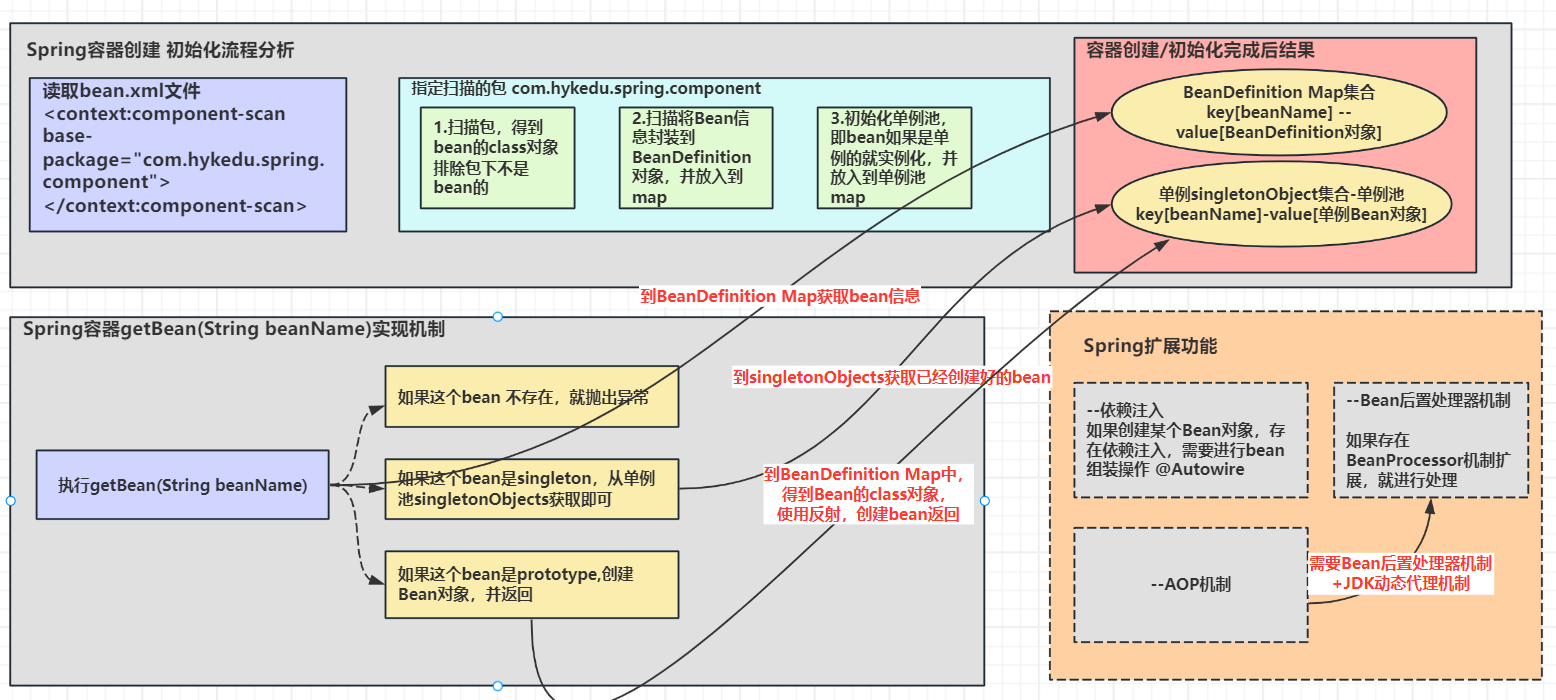
说明:整个实现思路,就是参考 Spring 规范
1.定义Autowired注解,实现了该注解的属性将会被进行依赖注入(看下面代码实现)
package com.hykedu.spring.annotation;
import java.lang.annotation.ElementType;
import java.lang.annotation.Retention;
import java.lang.annotation.RetentionPolicy;
import java.lang.annotation.Target;
/**
* @author 程序员蛇皮
* @version 1.0
*/
@Target({ElementType.METHOD, ElementType.FIELD,})
@Retention(RetentionPolicy.RUNTIME)
public @interface Autowired {
}
2.编辑CodeSnakeSpringApplicationContext类,在createBean方法增加识别Autowired注解进行依赖注入的功能
//完成createBean(BeanDefinition beanDefinition)方法
private Object createBean(BeanDefinition beanDefinition, String beanName) {
//得到Bean的clazz对象
Class clazz = beanDefinition.getClazz();
try {
//使用反射得到对象实例
Object instance = clazz.getDeclaredConstructor().newInstance();
//依赖注入
//1.遍历当前要创建的对象的所有字段
for (Field declaredField : clazz.getDeclaredFields()) {
//2.判断这个字段是否有@Autowired
if (declaredField.isAnnotationPresent(Autowired.class)) {
//3.得到这个字段的名字
String name = declaredField.getName();
System.out.println("字段名:" + name);
//4.通过getBean()获取要组装的对象
Object bean = getBean(name);
//5.进行组装
//私有属性需要进行反射暴破
declaredField.setAccessible(true);
declaredField.set(instance, bean);
}
}
System.out.println("------------------------------------------------------------------------------------------------------------------------------------------------");
System.out.println("=====创建好实例=====" + instance);
if (instance != null) {
return instance;
}
} catch (Exception e) {
throw new RuntimeException(e);
}
return null;
}
3.在StudentDao类中定义hi()方法,在StudentService类中定义m1()方法,在m1()调用StudentDao类的hi()方法
StudentDao.java
package com.hykedu.spring.component;
import com.hykedu.spring.annotation.Component;
/**
* @author 程序员蛇皮
* @version 1.0
*/
@Component
public class StudentDao {
public void hi() {
System.out.println("StudentDao hi~");
}
}
StudentService.java
package com.hykedu.spring.component;
import com.hykedu.spring.annotation.Autowired;
import com.hykedu.spring.annotation.Component;
import com.hykedu.spring.annotation.Scope;
/**
* @author 程序员蛇皮
* @version 1.0
*/
@Scope(value = "prototype")
@Component
public class StudentService {
//这里我们使用自己的 @Autowired 来修饰属性
//表示该属性,是通过容器完成依赖注入
//我们这里实现按照名字进行组装
@Autowired
private StudentDao studentDao;
public void m1(){
studentDao.hi();
}
}
测试方法AppMain
package com.hykedu.spring;
import com.hykedu.spring.component.StudentDao;
import com.hykedu.spring.component.StudentService;
import com.hykedu.spring.ioc.CodeSnakeSpringApplicationContext;
import com.hykedu.spring.ioc.CodeSnakeSpringConfig;
/**
* @author 程序员蛇皮
* @version 1.0
*/
public class AppMain {
public static void main(String[] args) {
CodeSnakeSpringApplicationContext codeSnakeSpringApplicationContext = new CodeSnakeSpringApplicationContext(CodeSnakeSpringConfig.class);
StudentService studentService = (StudentService) codeSnakeSpringApplicationContext.getBean("studentService");
studentService.m1();
System.out.println("ok");
}
}
测试结果:StudentService中的StudentDao对象成功地进行了依赖注入
五、实现任务阶段 5- bean 后置处理器实现
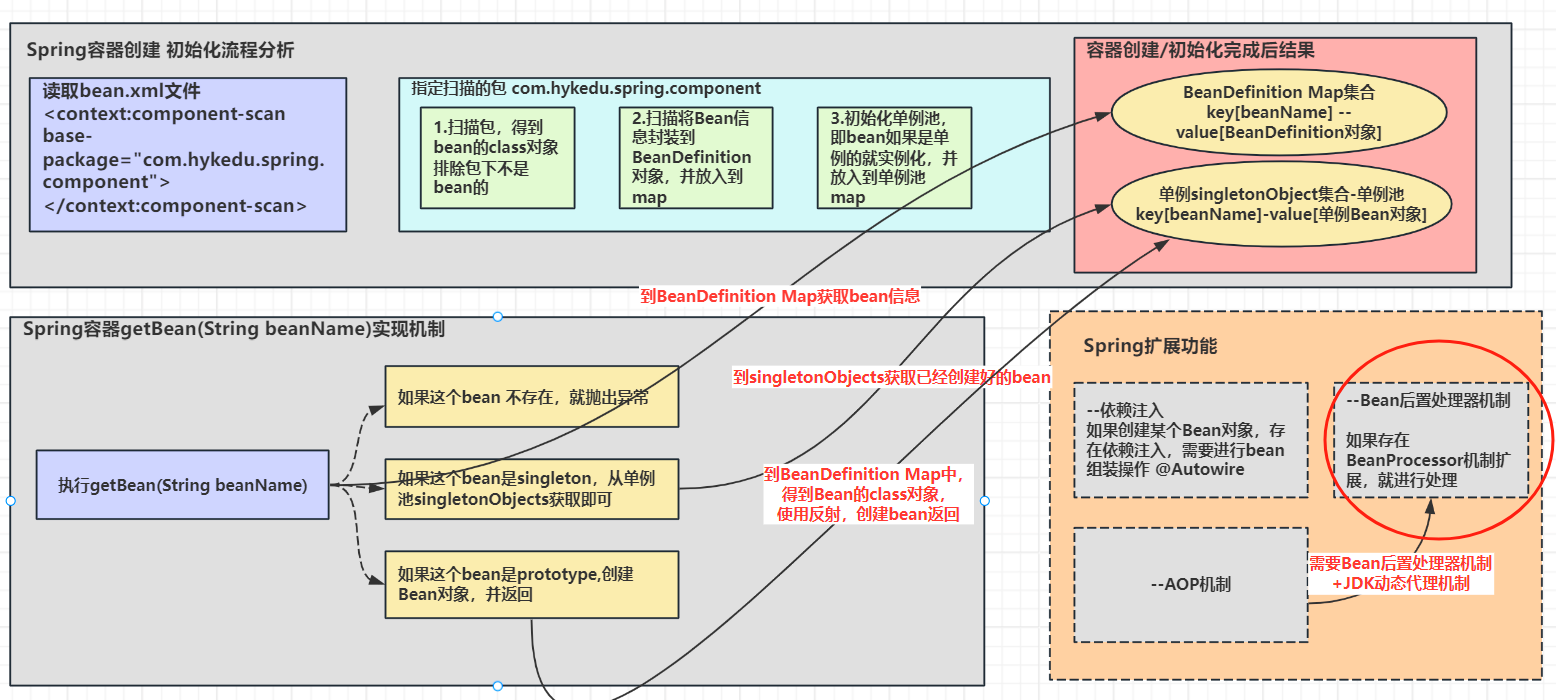
1.在processor包定义InitializingBean接口
实现该接口的 Bean , 需要实现 Bean 初始化方法, 可以参考 原生 Spring 规范来定义这个接口
package com.hykedu.spring.processor;
/**
* @author 程序员蛇皮
* @version 1.0
* 1.我们根据原生Spring 定义了一个InitializingBean
* 2.该 InitializingBean接口有一个void afterPropertiesSet() throws Exception;
* 3.afterPropertiesSet() 在bean的setter后执行,即等价于Spring原来的初始化方法init()
* 4.当一个Bean实现这个接口后,就实现afterPropertiesSet(),这个方法就是初始化方法
*/
public interface InitializingBean {
void afterPropertiesSet() throws Exception;
}
2.编辑CodeSnakeSpringApplicationContext类的createBean(BeanDefinition beanDefinition)方法,在创建好 Bean 实例后,判断是否需要进行初始化 【 容器中常用的一个方法是,根据该类是否实现了某个接口,来判断是否要执行某个业务逻辑, 这里其实就是 java 基础的接口编程实际运用】
//完成createBean(BeanDefinition beanDefinition)方法
private Object createBean(BeanDefinition beanDefinition, String beanName) {
//得到Bean的clazz对象
Class clazz = beanDefinition.getClazz();
try {
//使用反射得到对象实例
Object instance = clazz.getDeclaredConstructor().newInstance();
//依赖注入
//1.遍历当前要创建的对象的所有字段
for (Field declaredField : clazz.getDeclaredFields()) {
//2.判断这个字段是否有@Autowired
if (declaredField.isAnnotationPresent(Autowired.class)) {
//3.得到这个字段的名字
String name = declaredField.getName();
System.out.println("字段名:" + name);
//4.通过getBean()获取要组装的对象
Object bean = getBean(name);
//5.进行组装
//私有属性需要进行反射暴破
declaredField.setAccessible(true);
declaredField.set(instance, bean);
}
}
System.out.println("------------------------------------------------------------------------------------------------------------------------------------------------");
System.out.println("=====创建好实例=====" + instance);
//这里要判断是否要执行Bean的初始化方法
//1.判断当前创建的Bean对象是否实现了InitializingBean
//2.实现了InitializingBean就调用初始化方法
if (instance instanceof InitializingBean) {
try {
((InitializingBean) instance).afterPropertiesSet();
} catch (Exception e) {
throw new RuntimeException(e);
}
}
if (instance != null) {
return instance;
}
} catch (Exception e) {
throw new RuntimeException(e);
}
return null;
}
3.测试:在StudentService类中实现InitializingBean接口并重新初始化方法
package com.hykedu.spring.component;
import com.hykedu.spring.annotation.Autowired;
import com.hykedu.spring.annotation.Component;
import com.hykedu.spring.annotation.Scope;
import com.hykedu.spring.processor.InitializingBean;
/**
* @author 程序员蛇皮
* @version 1.0
*/
@Scope(value = "prototype")
@Component
public class StudentService implements InitializingBean {
//这里我们使用自己的 @Autowired 来修饰属性
//表示该属性,是通过容器完成依赖注入
//我们这里实现按照名字进行组装
@Autowired
private StudentDao studentDao;
public void m1(){
studentDao.hi();
}
@Override
public void afterPropertiesSet() throws Exception {
System.out.println("StudentService初始化方法");
}
}
测试方法AppMain
package com.hykedu.spring;
import com.hykedu.spring.component.StudentDao;
import com.hykedu.spring.component.StudentService;
import com.hykedu.spring.ioc.CodeSnakeSpringApplicationContext;
import com.hykedu.spring.ioc.CodeSnakeSpringConfig;
/**
* @author 程序员蛇皮
* @version 1.0
*/
public class AppMain {
public static void main(String[] args) {
CodeSnakeSpringApplicationContext codeSnakeSpringApplicationContext = new CodeSnakeSpringApplicationContext(CodeSnakeSpringConfig.class);
StudentDao studentDao1 = (StudentDao) codeSnakeSpringApplicationContext.getBean("studentDao");
StudentDao studentDao = (StudentDao) codeSnakeSpringApplicationContext.getBean("studentDao");
StudentService studentService1 = (StudentService) codeSnakeSpringApplicationContext.getBean("studentService");
StudentService studentService2 = (StudentService) codeSnakeSpringApplicationContext.getBean("studentService");
System.out.println("ok");
}
}
测试结果:实现了InitializingBean接口的对象都在创建好实例后执行了初始化方法

4.在processor包定义后置处理器BeanPostProcessor接口
package com.hykedu.spring.processor;
/**
* @author 程序员蛇皮
* @version 1.0
* 1.参考原生Spring容器,定义一个BeanPostProcessor接口
* 2.该接口有两个方法 postProcessBeforeInitialization(Object bean, String beanName)、postProcessAfterInitialization(Object bean, String beanName)
* 3.这两个方法会对Spring容器的所有Bean生效
*/
public interface BeanPostProcessor {
/**
* 1.postProcessBeforeInitialization在Bean的初始化前调用
* @param bean
* @param beanName
* @return
*/
default Object postProcessBeforeInitialization(Object bean, String beanName) {
return bean;
}
/**
* 1.postProcessAfterInitializatio在Bean的初始化后调用
* @param bean
* @param beanName
* @return
*/
default Object postProcessAfterInitialization(Object bean, String beanName) {
return bean;
}
}
5.在component包中定义MyProcessor类,该类实现了BeanPostProcessor接口,重写其中的方法
package com.hykedu.spring.component;
import com.hykedu.spring.annotation.Component;
import com.hykedu.spring.processor.BeanPostProcessor;
import java.lang.reflect.InvocationHandler;
import java.lang.reflect.Method;
import java.lang.reflect.Proxy;
/**
* @author 程序员蛇皮
* @version 1.0
* 1.这是我们自己的一个后置处理器
* 2.实现了BeanPostProcessor
* 3.我们可以重新before和after
* 4.在Spring容器中,仍然把MyBeanPostProcessor当作一个Bean对象,注入到容器中
* 5.@Component
*/
@Component
public class MyBeanPostProcessor implements BeanPostProcessor {
@Override
public Object postProcessBeforeInitialization(Object bean, String beanName) {
System.out.println("后置处理器postProcessBeforeInitialization()被调用 bean类型=" + bean.getClass() + " bean的名字=" + beanName);
return bean;
}
@Override
public Object postProcessAfterInitialization(Object bean, String beanName) {
System.out.println("后置处理器postProcessAfterInitialization()被调用 bean类型=" + bean.getClass() + " bean的名字=" + beanName);
return bean;
}
}
6.编辑CodeSnakeSpringApplicationContext类的scanBeanDefinition(Class configClass)和createBean(BeanDefinition beanDefinition)方法,在我们Bean的初始化方法前,调用后置处理器的before方法,在我们Bean的初始化方法后,调用后置处理器的after方法
package com.hykedu.spring.ioc;
import com.hykedu.spring.annotation.Autowired;
import com.hykedu.spring.annotation.Component;
import com.hykedu.spring.annotation.ComponentScan;
import com.hykedu.spring.annotation.Scope;
import com.hykedu.spring.processor.BeanPostProcessor;
import com.hykedu.spring.processor.InitializingBean;
import org.apache.commons.lang.StringUtils;
import java.io.File;
import java.lang.reflect.Field;
import java.net.URL;
import java.util.ArrayList;
import java.util.List;
import java.util.concurrent.ConcurrentHashMap;
/**
* @author 程序员蛇皮
* @version 1.0
* SpringApplicationContext 类的作用类似Spring原生ioc容器
*/
@SuppressWarnings("all")
public class CodeSnakeSpringApplicationContext {
private Class configClass;
//定义beanDefinitionMap,存放BeanDefinition对象
private final ConcurrentHashMap<String, BeanDefinition> beanDefinitionMap = new ConcurrentHashMap<>();
//定义singletonObjects,存放单例对象
private final ConcurrentHashMap<String, Object> singletonObjects = new ConcurrentHashMap<>();
//定义beanPostProcessors=>存放后置处理器
private final List<BeanPostProcessor> beanPostProcessors = new ArrayList<>();
public CodeSnakeSpringApplicationContext(Class configClass) {
scanBeanDefinition(configClass);
scanSingletonObjects();
}
//初始化单例池方法
private void scanSingletonObjects() {
//通过 beanDefinitionMap,初始化 singletonObjects 单例池
ConcurrentHashMap.KeySetView<String, BeanDefinition> keys = beanDefinitionMap.keySet();
for (String key : keys) {
BeanDefinition beanDefinition = beanDefinitionMap.get(key);
//判断该bean是singleton还是prototype
if ("singleton".equalsIgnoreCase(beanDefinition.getScope())) {
Object bean = createBean(beanDefinition, key);
singletonObjects.put(key, bean);
}
}
}
//该方法完成的对指定包的扫描,并将Bean信息封装到BeanDefinition对象,再放入map
private void scanBeanDefinition(Class configClass) {
this.configClass = configClass;
System.out.println(configClass);
//获取要扫描的包
//1.先得到SpringConfig配置的@ComponentScan(value = "com.hykedu.spring.component")
ComponentScan componentScan = (ComponentScan) this.configClass.getDeclaredAnnotation(ComponentScan.class);
//2.componentScan的value就是我们要扫描的包
String path = componentScan.value();
System.out.println("要扫描的包:" + path);
//得到要扫描的包下所有的资源(类.class)
//1.得到类的加载器
ClassLoader classLoader = CodeSnakeSpringApplicationContext.class.getClassLoader();
//2.通过类加载器获取到要扫描包的url
path = path.replace(".", "/");//把 . 替换成路径间隔符 /
URL resource = classLoader.getResource(path);
System.out.println("要扫描包的url:" + resource);
//3.将要加载的资源(.class) 路径下的文件进行遍历=>io
File file = new File(resource.getFile());
if (file.isDirectory()) {//pand
File[] files = file.listFiles();
for (File f : files) {
String absolutePath = f.getAbsolutePath();
System.out.println("文件的绝对路径:" + absolutePath);
//这里我们只处理.class文件
if (absolutePath.endsWith(".class")) {
//1.获取到类名
String className = absolutePath.substring
(absolutePath.lastIndexOf("\\") + 1, absolutePath.lastIndexOf(".class"));
System.out.println("类名:" + className);
//2.获取类的完整路径(全类名)
String classFullName = path.replace("/", ".") + "." + className;
System.out.println("全类名:" + classFullName);
//3.判断该类是否需要注入容器,判断该类是不是有@Component/@Controller/@Repository/@Service注解
try {
Class<?> clazz = classLoader.loadClass(classFullName);
if (clazz.isAnnotationPresent(Component.class)) {
//如果在注解指定了value,将其赋值给className
System.out.println("这是一个Spring bean" + clazz);
//1.这里为了方便,将后置处理器放入到ArrayList集合中
//2.如果发现是一个后置处理器,放入到beanPostProcessors
//3.在原生的Spring中,对后置处理器还是走的getBean,createBean,但是我们需要在singletonObjects加入相应的业务逻辑
//4.这里我们简化,用的ArrayList
//判断这个clazz有没有实现BeanPostProcessor
//说明:这里我们不能使用 instanceof 来判断clazz是否实现了BeanPostProcessor
//原因:clazz不是一个实例对象,而是一个类对象/clazz
if (BeanPostProcessor.class.isAssignableFrom(clazz)) {
BeanPostProcessor beanPostProcessor = (BeanPostProcessor) clazz.newInstance();
beanPostProcessors.add(beanPostProcessor);
continue;
}
Component componentAnnotation = clazz.getDeclaredAnnotation(Component.class);
String beanName = componentAnnotation.value();
if (beanName.equals("")) {
//将类名首字母小写作为beanName
beanName = StringUtils.uncapitalize(className);
}
BeanDefinition beanDefinition = new BeanDefinition();
beanDefinition.setClazz(clazz);
if (clazz.isAnnotationPresent(Scope.class)) {
//如果配置了Scope,获取他配置的值
Scope scopeAnnotation = clazz.getDeclaredAnnotation(Scope.class);
beanDefinition.setScope(scopeAnnotation.value());
} else {
//如果没有配置值,就默认Singleton
beanDefinition.setScope("singleton");
}
//将beanDefinition放入beanDefinitionMap
beanDefinitionMap.put(beanName, beanDefinition);
} else {
System.out.println("这不是一个Spring bean" + clazz);
}
} catch (Exception e) {
throw new RuntimeException(e);
}
}
}
}
}
//完成createBean(BeanDefinition beanDefinition)方法
private Object createBean(BeanDefinition beanDefinition, String beanName) {
//得到Bean的clazz对象
Class clazz = beanDefinition.getClazz();
try {
//使用反射得到对象实例
Object instance = clazz.getDeclaredConstructor().newInstance();
//依赖注入
//1.遍历当前要创建的对象的所有字段
for (Field declaredField : clazz.getDeclaredFields()) {
//2.判断这个字段是否有@Autowired
if (declaredField.isAnnotationPresent(Autowired.class)) {
//3.得到这个字段的名字
String name = declaredField.getName();
System.out.println("字段名:" + name);
//4.通过getBean()获取要组装的对象
Object bean = getBean(name);
//5.进行组装
//私有属性需要进行反射暴破
declaredField.setAccessible(true);
declaredField.set(instance, bean);
}
}
System.out.println("------------------------------------------------------------------------------------------------------------------------------------------------");
System.out.println("=====创建好实例=====" + instance);
//在我们Bean的初始化方法前,调用后置处理器的before方法
for (BeanPostProcessor beanPostProcessor : beanPostProcessors) {
Object current = beanPostProcessor.postProcessBeforeInitialization(instance, beanName);
if (current != null) {
instance = current;
}
}
//这里要判断是否要执行Bean的初始化方法
//1.判断当前创建的Bean对象是否实现了InitializingBean
//2.实现了InitializingBean就调用初始化方法
if (instance instanceof InitializingBean) {
try {
((InitializingBean) instance).afterPropertiesSet();
} catch (Exception e) {
throw new RuntimeException(e);
}
}
//在我们Bean的初始化方法后,调用后置处理器的after方法
for (BeanPostProcessor beanPostProcessor : beanPostProcessors) {
Object current = beanPostProcessor.postProcessAfterInitialization(instance, beanName);
if (current != null) {
instance = current;
}
}
if (instance != null) {
return instance;
}
} catch (Exception e) {
throw new RuntimeException(e);
}
return null;
}
//编写方法,返回容器的对象
public Object getBean(String name) {
if (beanDefinitionMap.containsKey(name)) {
BeanDefinition beanDefinition = beanDefinitionMap.get(name);
if ("singleton".equalsIgnoreCase(beanDefinition.getScope())) {
//说明是单例配置
return singletonObjects.get(name);
} else {//如果不是单例的,就反射一个新的对象
return createBean(beanDefinition, name);
}
}
throw new NullPointerException("没有该bean");
}
}
7.在AppMain中进行测试
测试结果:成功在初始化方法前后调用后置处理器方法

六、实现任务阶段 6- AOP 机制实现
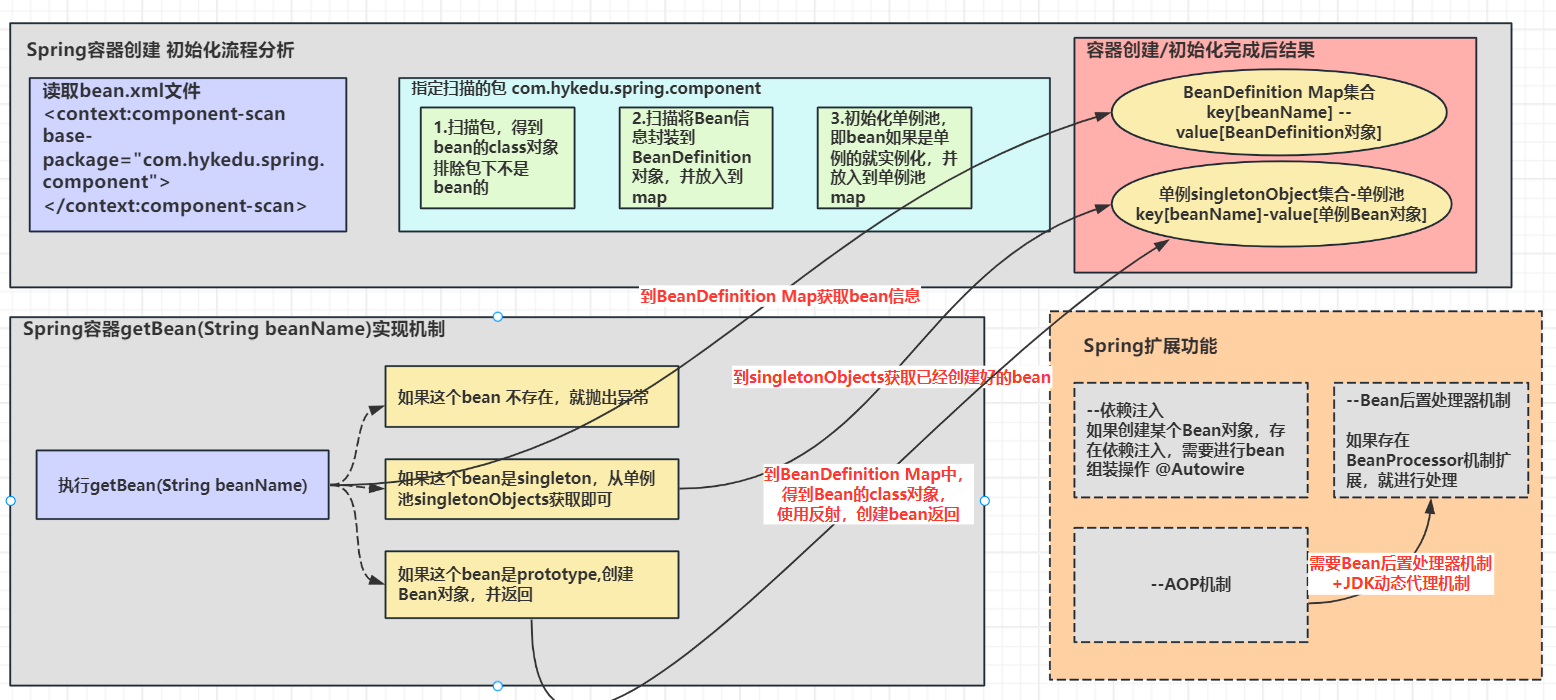
AOP作用示意图
 因为原生Spring的AOP是在初始化方法后进行的动态代理,所有我们在后置处理器中的postProcessAfterInitialization(Object bean, String beanName)中编写动态代理代码
因为原生Spring的AOP是在初始化方法后进行的动态代理,所有我们在后置处理器中的postProcessAfterInitialization(Object bean, String beanName)中编写动态代理代码
1.分别定义SmartAnimalable接口、实现了SmartAnimalable接口的SmartDog类、切面类SmartAnimalAspect
package com.hykedu.spring.component;
/**
* @author 程序员蛇皮
* @version 1.0
*/
public interface SmartAnimalable {
float getSum(float i,float j);
float getSub(float i,float j);
}
package com.hykedu.spring.component;
import com.hykedu.spring.annotation.Component;
/**
* @author 程序员蛇皮
* @version 1.0
*/
@Component
public class SmartDog implements SmartAnimalable {
@Override
public float getSum(float i, float j) {
float result = i + j;
// result = 1/0;//模拟一个算术异常
System.out.println("方法内部打印result = " + result);
return result;
}
@Override
public float getSub(float i, float j) {
float result = i - j;
System.out.println("方法内部打印result = " + result);
return result;
}
}
package com.hykedu.spring.component;
import com.hykedu.spring.annotation.Component;
/**
* @author 程序员蛇皮
* @version 1.0
* SmartAnimalAspect我们当作一个切面类来使用
*/
@Component
public class SmartAnimalAspect {
public static void showBeginLog(){
System.out.println("前置通知..");
}
public static void showSuccessLog(){
System.out.println("返回通知..");
}
}
说明:这里我们只对SmartDog的getSum(float i, float j)方法进行切入,写得比较死,如果要写灵活还是使用注解那一套,只不过跟aop关系不大了,这里就用写死的办法
2.修改后置处理器中的postProcessAfterInitialization(Object bean, String beanName)方法
@Override
public Object postProcessAfterInitialization(Object bean, String beanName) {
System.out.println("后置处理器postProcessAfterInitialization()被调用 bean类型=" + bean.getClass() + " bean的名字=" + beanName);
//实现AOP,返回代理对象,即对Bean进行包装
if ("smartDog".equals(beanName)) {
//使用JDK的动态代理,返回bean的代理对象
Object proxyInstance = Proxy.newProxyInstance(MyBeanPostProcessor.class.getClassLoader(),
bean.getClass().getInterfaces(), new InvocationHandler() {
@Override
public Object invoke(Object proxy, Method method, Object[] args) throws Throwable {
Object result = null;
if ("getSum".equals(method.getName())) {
SmartAnimalAspect.showBeginLog();
result = method.invoke(bean, args);
SmartAnimalAspect.showSuccessLog();
} else {
result = method.invoke(bean, args);
}
return result;
}
});
//如果Bean需要返回代理对象
return proxyInstance;
}
//如果不需要AOP,返回原生Bean对象
return bean;
}
测试方法AppMain
package com.hykedu.spring;
import com.hykedu.spring.component.SmartAnimalAspect;
import com.hykedu.spring.component.SmartAnimalable;
import com.hykedu.spring.component.StudentDao;
import com.hykedu.spring.component.StudentService;
import com.hykedu.spring.ioc.CodeSnakeSpringApplicationContext;
import com.hykedu.spring.ioc.CodeSnakeSpringConfig;
/**
* @author 程序员蛇皮
* @version 1.0
*/
public class AppMain {
public static void main(String[] args) {
CodeSnakeSpringApplicationContext codeSnakeSpringApplicationContext = new CodeSnakeSpringApplicationContext(CodeSnakeSpringConfig.class);
SmartAnimalable smartDog = (SmartAnimalable) codeSnakeSpringApplicationContext.getBean("smartDog");
smartDog.getSum(10,10);
System.out.println("ok");
}
}
测试结果:成功在SmartDog的getSum(float i, float j)方法前后切入前置通知和后置通知

七、手动实现 Spring 底层机制【初始化 IOC容器+依赖注入+BeanPostProcessor 机制+AOP】完整代码
annotation包
package com.hykedu.spring.annotation;
import java.lang.annotation.ElementType;
import java.lang.annotation.Retention;
import java.lang.annotation.RetentionPolicy;
import java.lang.annotation.Target;
/**
* @author 程序员蛇皮
* @version 1.0
*/
@Target({ElementType.METHOD, ElementType.FIELD,})
@Retention(RetentionPolicy.RUNTIME)
public @interface Autowired {
}
package com.hykedu.spring.annotation;
import java.lang.annotation.ElementType;
import java.lang.annotation.Retention;
import java.lang.annotation.RetentionPolicy;
import java.lang.annotation.Target;
/**
* @author 程序员蛇皮
* @version 1.0
* 1.@Target(ElementType.TYPE)指定我们的 ComponentScan注解可以修饰 Type程序元素
* 2.@Retention(RetentionPolicy.RUNTIME) ComponentScan注解 保留范围
* 3.String value() default ""; 表示 ComponentScan注解 可以传入value
*/
@Target(ElementType.TYPE)
@Retention(RetentionPolicy.RUNTIME)
public @interface Component {
String value() default "";
}
package com.hykedu.spring.annotation;
import java.lang.annotation.ElementType;
import java.lang.annotation.Retention;
import java.lang.annotation.RetentionPolicy;
import java.lang.annotation.Target;
/**
* @author 程序员蛇皮
* @version 1.0
* 1.@Target(ElementType.TYPE)指定我们的 ComponentScan注解可以修饰 Type程序元素
* 2.@Retention(RetentionPolicy.RUNTIME) ComponentScan注解 保留范围
* 3.String value() default ""; 表示 ComponentScan注解 可以传入value
*/
@Target(ElementType.TYPE)
@Retention(RetentionPolicy.RUNTIME)
public @interface ComponentScan {
String value() default "";
}
package com.hykedu.spring.annotation;
import java.lang.annotation.ElementType;
import java.lang.annotation.Retention;
import java.lang.annotation.RetentionPolicy;
import java.lang.annotation.Target;
/**
* @author 程序员蛇皮
* @version 1.0
* Scope可以指定bean的作用范围[singleton,prototype]
*/
@Target(ElementType.TYPE)
@Retention(RetentionPolicy.RUNTIME)
public @interface Scope {
String value() default "";
}
component包
package com.hykedu.spring.component;
/**
* @author 程序员蛇皮
* @version 1.0
*/
public class Car {
}
package com.hykedu.spring.component;
import com.hykedu.spring.annotation.Component;
import com.hykedu.spring.processor.BeanPostProcessor;
import java.lang.reflect.InvocationHandler;
import java.lang.reflect.Method;
import java.lang.reflect.Proxy;
/**
* @author 程序员蛇皮
* @version 1.0
* 1.这是我们自己的一个后置处理器
* 2.实现了BeanPostProcessor
* 3.我们可以重新before和after
* 4.在Spring容器中,仍然把MyBeanPostProcessor当作一个Bean对象,注入到容器中
* 5.@Component
*/
@Component
public class MyBeanPostProcessor implements BeanPostProcessor {
@Override
public Object postProcessBeforeInitialization(Object bean, String beanName) {
System.out.println("后置处理器postProcessBeforeInitialization()被调用 bean类型=" + bean.getClass() + " bean的名字=" + beanName);
return bean;
}
@Override
public Object postProcessAfterInitialization(Object bean, String beanName) {
System.out.println("后置处理器postProcessAfterInitialization()被调用 bean类型=" + bean.getClass() + " bean的名字=" + beanName);
//实现AOP,返回代理对象,即对Bean进行包装
if ("smartDog".equals(beanName)) {
//使用JDK的动态代理,返回bean的代理对象
Object proxyInstance = Proxy.newProxyInstance(MyBeanPostProcessor.class.getClassLoader(),
bean.getClass().getInterfaces(), new InvocationHandler() {
@Override
public Object invoke(Object proxy, Method method, Object[] args) throws Throwable {
Object result = null;
if ("getSum".equals(method.getName())) {
SmartAnimalAspect.showBeginLog();
result = method.invoke(bean, args);
SmartAnimalAspect.showSuccessLog();
} else {
result = method.invoke(bean, args);
}
return result;
}
});
//如果Bean需要返回代理对象
return proxyInstance;
}
//如果不需要AOP,返回原生Bean对象
return bean;
}
}
package com.hykedu.spring.component;
/**
* @author 程序员蛇皮
* @version 1.0
*/
public interface SmartAnimalable {
float getSum(float i,float j);
float getSub(float i,float j);
}
package com.hykedu.spring.component;
import com.hykedu.spring.annotation.Component;
/**
* @author 程序员蛇皮
* @version 1.0
* SmartAnimalAspect我们当作一个切面类来使用
*/
//@Component
public class SmartAnimalAspect {
public static void showBeginLog(){
System.out.println("前置通知..");
}
public static void showSuccessLog(){
System.out.println("返回通知..");
}
}
package com.hykedu.spring.component;
import com.hykedu.spring.annotation.Component;
/**
* @author 程序员蛇皮
* @version 1.0
*/
@Component
public class SmartDog implements SmartAnimalable {
@Override
public float getSum(float i, float j) {
float result = i + j;
// result = 1/0;//模拟一个算术异常
System.out.println("方法内部打印result = " + result);
return result;
}
@Override
public float getSub(float i, float j) {
float result = i - j;
System.out.println("方法内部打印result = " + result);
return result;
}
}
package com.hykedu.spring.component;
import com.hykedu.spring.annotation.Component;
/**
* @author 程序员蛇皮
* @version 1.0
*/
@Component
public class StudentDao {
public void hi() {
System.out.println("StudentDao hi~");
}
}
package com.hykedu.spring.component;
import com.hykedu.spring.annotation.Autowired;
import com.hykedu.spring.annotation.Component;
import com.hykedu.spring.annotation.Scope;
import com.hykedu.spring.processor.InitializingBean;
/**
* @author 程序员蛇皮
* @version 1.0
*/
@Scope(value = "prototype")
@Component
public class StudentService implements InitializingBean {
//这里我们使用自己的 @Autowired 来修饰属性
//表示该属性,是通过容器完成依赖注入
//我们这里实现按照名字进行组装
@Autowired
private StudentDao studentDao;
public void m1(){
studentDao.hi();
}
@Override
public void afterPropertiesSet() throws Exception {
System.out.println("StudentService初始化方法");
}
}
ioc包
package com.hykedu.spring.ioc;
/**
* @author 程序员蛇皮
* @version 1.0
* BeanDefinition 用于封装/记录Bean的信息[1.scope 2.Bean对应的Class对象,反射可以生成对应的对象
*/
@SuppressWarnings("all")
public class BeanDefinition {
private String scope;
private Class clazz;
public String getScope() {
return scope;
}
public void setScope(String scope) {
this.scope = scope;
}
public Class getClazz() {
return clazz;
}
public void setClazz(Class clazz) {
this.clazz = clazz;
}
@Override
public String toString() {
return "BeanDefinition{" +
"scope='" + scope + '\'' +
", clazz=" + clazz +
'}';
}
}
package com.hykedu.spring.ioc;
import com.hykedu.spring.annotation.Autowired;
import com.hykedu.spring.annotation.Component;
import com.hykedu.spring.annotation.ComponentScan;
import com.hykedu.spring.annotation.Scope;
import com.hykedu.spring.processor.BeanPostProcessor;
import com.hykedu.spring.processor.InitializingBean;
import org.apache.commons.lang.StringUtils;
import java.io.File;
import java.lang.reflect.Field;
import java.net.URL;
import java.util.ArrayList;
import java.util.List;
import java.util.concurrent.ConcurrentHashMap;
/**
* @author 程序员蛇皮
* @version 1.0
* CodeSnakeSpringApplicationContext 类的作用类似Spring原生ioc容器
*/
@SuppressWarnings("all")
public class CodeSnakeSpringApplicationContext {
private Class configClass;
//定义beanDefinitionMap,存放BeanDefinition对象
private final ConcurrentHashMap<String, BeanDefinition> beanDefinitionMap = new ConcurrentHashMap<>();
//定义singletonObjects,存放单例对象
private final ConcurrentHashMap<String, Object> singletonObjects = new ConcurrentHashMap<>();
//定义beanPostProcessors=>存放后置处理器
private final List<BeanPostProcessor> beanPostProcessors = new ArrayList<>();
public CodeSnakeSpringApplicationContext(Class configClass) {
scanBeanDefinition(configClass);
scanSingletonObjects();
}
//初始化单例池方法
private void scanSingletonObjects() {
//通过 beanDefinitionMap,初始化 singletonObjects 单例池
ConcurrentHashMap.KeySetView<String, BeanDefinition> keys = beanDefinitionMap.keySet();
for (String key : keys) {
BeanDefinition beanDefinition = beanDefinitionMap.get(key);
//判断该bean是singleton还是prototype
if ("singleton".equalsIgnoreCase(beanDefinition.getScope())) {
Object bean = createBean(beanDefinition, key);
singletonObjects.put(key, bean);
}
}
}
//该方法完成的对指定包的扫描,并将Bean信息封装到BeanDefinition对象,再放入map
private void scanBeanDefinition(Class configClass) {
this.configClass = configClass;
System.out.println(configClass);
//获取要扫描的包
//1.先得到SpringConfig配置的@ComponentScan(value = "com.hykedu.spring.component")
ComponentScan componentScan = (ComponentScan) this.configClass.getDeclaredAnnotation(ComponentScan.class);
//2.componentScan的value就是我们要扫描的包
String path = componentScan.value();
System.out.println("要扫描的包:" + path);
//得到要扫描的包下所有的资源(类.class)
//1.得到类的加载器
ClassLoader classLoader = CodeSnakeSpringApplicationContext.class.getClassLoader();
//2.通过类加载器获取到要扫描包的url
path = path.replace(".", "/");//把 . 替换成路径间隔符 /
URL resource = classLoader.getResource(path);
System.out.println("要扫描包的url:" + resource);
//3.将要加载的资源(.class) 路径下的文件进行遍历=>io
File file = new File(resource.getFile());
if (file.isDirectory()) {//pand
File[] files = file.listFiles();
for (File f : files) {
String absolutePath = f.getAbsolutePath();
System.out.println("文件的绝对路径:" + absolutePath);
//这里我们只处理.class文件
if (absolutePath.endsWith(".class")) {
//1.获取到类名
String className = absolutePath.substring
(absolutePath.lastIndexOf("\\") + 1, absolutePath.lastIndexOf(".class"));
System.out.println("类名:" + className);
//2.获取类的完整路径(全类名)
String classFullName = path.replace("/", ".") + "." + className;
System.out.println("全类名:" + classFullName);
//3.判断该类是否需要注入容器,判断该类是不是有@Component/@Controller/@Repository/@Service注解
try {
Class<?> clazz = classLoader.loadClass(classFullName);
if (clazz.isAnnotationPresent(Component.class)) {
//如果在注解指定了value,将其赋值给className
System.out.println("这是一个Spring bean" + clazz);
//1.这里为了方便,将后置处理器放入到ArrayList集合中
//2.如果发现是一个后置处理器,放入到beanPostProcessors
//3.在原生的Spring中,对后置处理器还是走的getBean,createBean,但是我们需要在singletonObjects加入相应的业务逻辑
//4.这里我们简化,用的ArrayList
//判断这个clazz有没有实现BeanPostProcessor
//说明:这里我们不能使用 instanceof 来判断clazz是否实现了BeanPostProcessor
//原因:clazz不是一个实例对象,而是一个类对象/clazz
if (BeanPostProcessor.class.isAssignableFrom(clazz)) {
BeanPostProcessor beanPostProcessor = (BeanPostProcessor) clazz.newInstance();
beanPostProcessors.add(beanPostProcessor);
continue;
}
Component componentAnnotation = clazz.getDeclaredAnnotation(Component.class);
String beanName = componentAnnotation.value();
if (beanName.equals("")) {
//将类名首字母小写作为beanName
beanName = StringUtils.uncapitalize(className);
}
BeanDefinition beanDefinition = new BeanDefinition();
beanDefinition.setClazz(clazz);
if (clazz.isAnnotationPresent(Scope.class)) {
//如果配置了Scope,获取他配置的值
Scope scopeAnnotation = clazz.getDeclaredAnnotation(Scope.class);
beanDefinition.setScope(scopeAnnotation.value());
} else {
//如果没有配置值,就默认Singleton
beanDefinition.setScope("singleton");
}
//将beanDefinition放入beanDefinitionMap
beanDefinitionMap.put(beanName, beanDefinition);
} else {
System.out.println("这不是一个Spring bean" + clazz);
}
} catch (Exception e) {
throw new RuntimeException(e);
}
}
}
}
}
//完成createBean(BeanDefinition beanDefinition)方法
private Object createBean(BeanDefinition beanDefinition, String beanName) {
//得到Bean的clazz对象
Class clazz = beanDefinition.getClazz();
try {
//使用反射得到对象实例
Object instance = clazz.getDeclaredConstructor().newInstance();
//依赖注入
//1.遍历当前要创建的对象的所有字段
for (Field declaredField : clazz.getDeclaredFields()) {
//2.判断这个字段是否有@Autowired
if (declaredField.isAnnotationPresent(Autowired.class)) {
//3.得到这个字段的名字
String name = declaredField.getName();
System.out.println("字段名:" + name);
//4.通过getBean()获取要组装的对象
Object bean = getBean(name);
//5.进行组装
//私有属性需要进行反射暴破
declaredField.setAccessible(true);
declaredField.set(instance, bean);
}
}
System.out.println("------------------------------------------------------------------------------------------------------------------------------------------------");
System.out.println("=====创建好实例=====" + instance);
//在我们Bean的初始化方法前,调用后置处理器的before方法
for (BeanPostProcessor beanPostProcessor : beanPostProcessors) {
Object current = beanPostProcessor.postProcessBeforeInitialization(instance, beanName);
if (current != null) {
instance = current;
}
}
//这里要判断是否要执行Bean的初始化方法
//1.判断当前创建的Bean对象是否实现了InitializingBean
//2.实现了InitializingBean就调用初始化方法
if (instance instanceof InitializingBean) {
try {
((InitializingBean) instance).afterPropertiesSet();
} catch (Exception e) {
throw new RuntimeException(e);
}
}
//在我们Bean的初始化方法后,调用后置处理器的after方法
for (BeanPostProcessor beanPostProcessor : beanPostProcessors) {
Object current = beanPostProcessor.postProcessAfterInitialization(instance, beanName);
if (current != null) {
instance = current;
}
}
if (instance != null) {
return instance;
}
} catch (Exception e) {
throw new RuntimeException(e);
}
return null;
}
//编写方法,返回容器的对象
public Object getBean(String name) {
if (beanDefinitionMap.containsKey(name)) {
BeanDefinition beanDefinition = beanDefinitionMap.get(name);
if ("singleton".equalsIgnoreCase(beanDefinition.getScope())) {
//说明是单例配置
return singletonObjects.get(name);
} else {//如果不是单例的,就反射一个新的对象
return createBean(beanDefinition, name);
}
}
throw new NullPointerException("没有该bean");
}
}
package com.hykedu.spring.ioc;
import com.hykedu.spring.annotation.ComponentScan;
/**
* @author 程序员蛇皮
* @version 1.0
* 这是一个配置类,作用类似于原生Spring的 beans.xml 容器配置文件
*/
@ComponentScan(value = "com.hykedu.spring.component")
public class CodeSnakeSpringConfig {
}
processor包
package com.hykedu.spring.processor;
/**
* @author 程序员蛇皮
* @version 1.0
* 1.参考原生Spring容器,定义一个BeanPostProcessor接口
* 2.该接口有两个方法 postProcessBeforeInitialization(Object bean, String beanName)、postProcessAfterInitialization(Object bean, String beanName)
* 3.这两个方法会对Spring容器的所有Bean生效
*/
public interface BeanPostProcessor {
/**
* 1.postProcessBeforeInitialization在Bean的初始化前调用
* @param bean
* @param beanName
* @return
*/
default Object postProcessBeforeInitialization(Object bean, String beanName) {
return bean;
}
/**
* 1.postProcessAfterInitializatio在Bean的初始化后调用
* @param bean
* @param beanName
* @return
*/
default Object postProcessAfterInitialization(Object bean, String beanName) {
return bean;
}
}
package com.hykedu.spring.processor;
/**
* @author 程序员蛇皮
* @version 1.0
* 1.我们根据原生Spring 定义了一个InitializingBean
* 2.该 InitializingBean接口有一个void afterPropertiesSet() throws Exception;
* 3.afterPropertiesSet() 在bean的setter后执行,即等价于Spring原来的初始化方法init()
* 4.当一个Bean实现这个接口后,就实现afterPropertiesSet(),这个方法就是初始化方法
*/
public interface InitializingBean {
void afterPropertiesSet() throws Exception;
}
测试类
package com.hykedu.spring;
import com.hykedu.spring.component.SmartAnimalAspect;
import com.hykedu.spring.component.SmartAnimalable;
import com.hykedu.spring.component.StudentDao;
import com.hykedu.spring.component.StudentService;
import com.hykedu.spring.ioc.CodeSnakeSpringApplicationContext;
import com.hykedu.spring.ioc.CodeSnakeSpringConfig;
/**
* @author 程序员蛇皮
* @version 1.0
*/
public class AppMain {
public static void main(String[] args) {
CodeSnakeSpringApplicationContext codeSnakeSpringApplicationContext = new CodeSnakeSpringApplicationContext(CodeSnakeSpringConfig.class);
SmartAnimalable smartDog = (SmartAnimalable) codeSnakeSpringApplicationContext.getBean("smartDog");
StudentDao studentDao1 = (StudentDao) codeSnakeSpringApplicationContext.getBean("studentDao");
StudentDao studentDao = (StudentDao) codeSnakeSpringApplicationContext.getBean("studentDao");
StudentService studentService1 = (StudentService) codeSnakeSpringApplicationContext.getBean("studentService");
StudentService studentService2 = (StudentService) codeSnakeSpringApplicationContext.getBean("studentService");
smartDog.getSum(10,10);
System.out.println("ok");
}






















 165
165

 被折叠的 条评论
为什么被折叠?
被折叠的 条评论
为什么被折叠?








